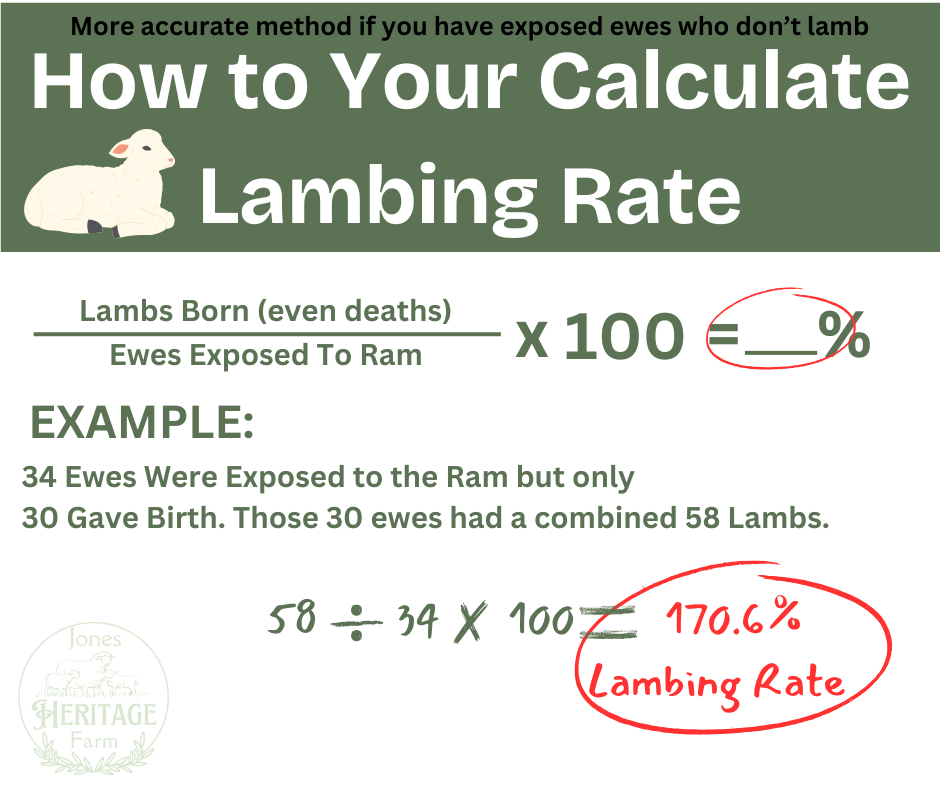Wouldn’t having an educated guess of how many lambs your ewes may be having this year be nice? How about having a number that can show you that you have potential areas for improvement in your flock? Well, if you have your prior year’s lambing stats, you can get that basic guess. With your percentage in hand, you can also see if your flock is falling short of your goals. Well, with this short post, we’ll show you how with a super simple equation that’s pretty popular among sheep producers.
Why Do People Calculate Lambing Rates?
If you’re raising sheep for profit, you want your flock to have the best reproductive efficiency possible. This means that you want your ewes that are exposed to rams to get pregnant, carry to term, and safely deliver as many lambs as they can. More lambs born equals more lambs to sell and more pounds of meat to raise, which increases your profit.
Calculating lambing rates is a wonderful way to show you if your flock is falling short, meeting or exceeding your expectations. It gives you a baseline to work towards if your numbers are lower than you’d like. Also, you can use your previous year’s lambing stats to guess how many lambs you may expect to have next lambing season! If you want to see what we have in our lambing kit, click here.
Two Ways To Calculate Lambing Rates

METHOD 1: One way to calculate your lambing rate is to use the number of your ewes that are lambing. Example: If you had put 34 ewes in with your ram in the fall, but only 30 of them had lambs come spring, you’re only using the 30 in your equation and just ignoring those other 4. See Example 1 above.
This method is how we calculate the lambing rate on our farm. Mainly because we have never yet had a ewe who did not get bred when she was put with a ram. Because of that, the equation works out the same for us either way. If you have ewes that don’t lamb after being exposed, you will probably want to use Method #2 to get the most accurate results.
METHOD 2: The method below displays the most accurate method for calculating your lambing rate if you have exposed ewes who didn’t lamb. It could be due to not conceiving, miscarriage or any unknown reason for not delivering. If all of your exposed ewes had lambs, then either of the 2 methods will give you the exact same results. See the example below.

Now That I Have The Lambing Rate for This Lambing Season on My Farm, How Do I Use This Percentage?
Here’s where the fun comes in; how to apply it. Let’s start with the most fun way to use it. After that, we’ll get to the part that requires more work:
Use your lambing rate to guess how many lambs might be born in your next lambing season.
Multiplying your lambing percentage by the number of ewes that are exposed will show an estimate of how many lambs might be born during lambing season.
EXAMPLE: Let’s say the lambing percentage for a farm is 171%, and there are 58 ewes that are exposed to a ram:
171% x 58 = 99.18 lambs born
I don’t even want to know what 0.18 of a lamb is, so I always round up. So that farm may have around 100 lambs born. Of course, this number can be different as things vary from year to year. So many things affect lambing rates: yearlings vs. older ewes, genetics, feed supply and quality, etc. For an even better baseline guess, record lambing rates for a few years. Then find your average lambing rate to use for your guesses, assuming they’re all fairly close to the same rate.
Use your lambing rate as a baseline to increase the reproductive efficiency of your flock.
This is the one that takes the most work but can yield the most profit if that’s what you’re after.
Here’s a great publication from Penn State on lambing rates. It includes what the American Sheep Industry recommends as baseline lambing percentages for flocks of varying sizes: https://extension.psu.edu/does-your-flock-meet-your-performance-expectations
How to Raise Lambing Rates
I won’t go into depth about how to raise your lambing rates, but I’ll give a brief rundown. In general, a few ways lambing rate percentages may be increased are by:
-Selecting ewes who have the tendency for multiples in their genetics.
-Culling ewes who consistently give singles or who don’t get bred/carry to term consistently.
-Possibly upping the quality or quantity of feeds if that may be a factor.
These are just a few of the many ways, but remember that all are not created equal. Some genetics are predisposed to produce big healthy singles, and that’s totally great if that’s what’s important to you. Some feed is just lower quality in some areas. So trying to push for lots of multiples could be asking for trouble in the health of your flock and their lambs. It’s not always the best thing to compare your farm to others. Someone working hard to enhance the genetics of a specific breed of sheep is probably going to have different goals than someone who only breeds a handful for meat, and that’s ok.
Happy Lambing Season to All!
Now that you’re armed with your lambing rate percentage, how do you plan to use it?

